Visit Dubrovnik, the “Pearl of the Adriatic”
“The Pearl of the Adriatic.” With a nickname like that, it’s hard not to expect sheer magnificence when you visit Dubrovnik, Croatia. And I can honestly say that Dubrovnik is one of the very few cities that actually does live up to its hype—of all the cities that I’ve visited so far, only New York City, Sydney and Venice have made similar overwhelming impressions on me.

Boats bobbing in the Harbor of Dubrovnik
Brief History of Dubrovnik
Let’s start with a brief historic overview, which will help you understand better why Dubrovnik is such a unique city. After being established about 1,300 years ago by Greek refugees, Dubrovnik was under control of first the Byzantine Empire and later Venice until the 14th century. Dubrovnik, known as Ragusa until as late as 1918, became an independent republic in 1358 and grew to become one of Venice’s major rivals in the Mediterranean. The city became one of the wealthiest in Europe, trading and doing business with places all over the Mediterranean, from Turkey in the east to Spain in the west, from France in the north to Egypt in the south.
Its heyday was in the 15th and 16th centuries, during which it was an independent republic, yet also a vassal of the mighty Ottoman Empire. In 1669, Dubrovnik sold a small stretch of land to its north to the Ottoman Empire to create a buffer between itself and advancing Venetian troops. This small stretch is now a part of Bosnia and Herzegovina and is that country’s only access to the Adriatic Sea. Two devastating 17th-century earthquakes combined with the creation of new trade routes resulted in Dubrovnik’s loss of much of its power and wealth. Napoleon’s conquest of the city state in 1808 marked the end of its independence.
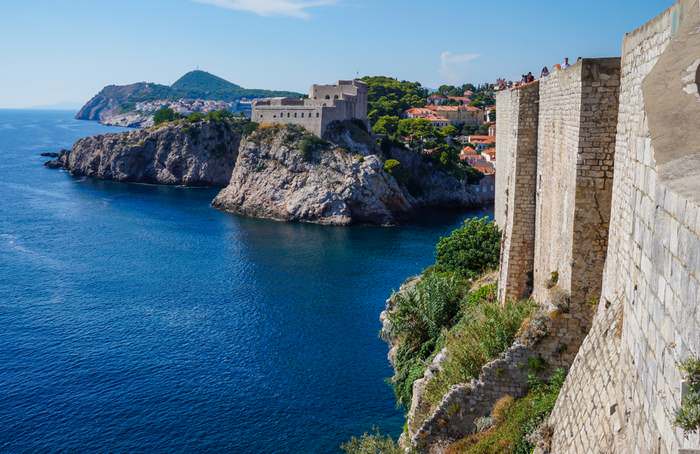
The magnificent City Walls of Dubrovnik
Because of this centuries-long history of independence, Dubrovnik still clings to its former freedom—signs saying “Libertas”, Latin for liberty, can be seen all over the city.
Nowadays, Dubrovnik is an undeniable part of Croatia, although it is still separated from other parts of mainland Croatia by that tiny piece of Bosnia and Herzegovina territory. If you want to reach Dubrovnik from other parts of Croatia and don’t want to leave the country—which, in case you rent a car in Italy, is not allowed in the first place—you will have to take a ferry.
Modern Day Dubrovnik
Modern-day Dubrovnik consists of the fairy tale-like Old Town and the densely populated suburbs, spectacular beaches and a number of islands. Forget about those suburbs, although they may offer the cheapest accommodation, and focus on the jaw-dropping Old Town, which in its entirety is a UNESCO World Heritage Site.
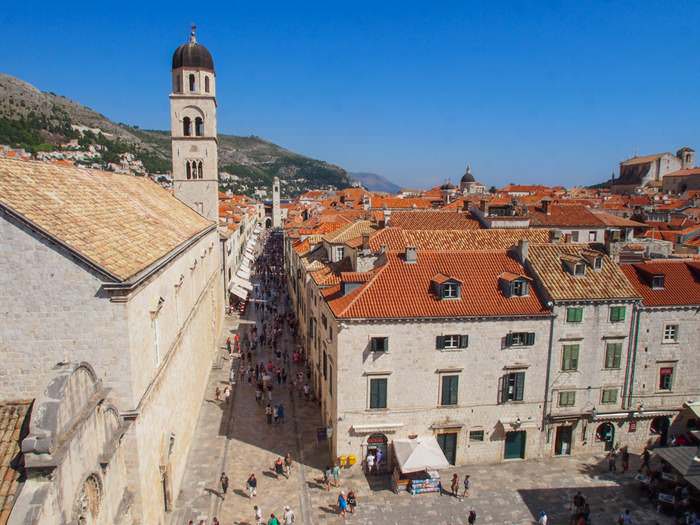
Stradun seen from the City Walls
Stradun is the name of the main street in Dubrovnik’s Old Town, which incidentally is completely traffic-free. Souvenir shops, monasteries and cafés and restaurants line this wide street, while narrow side streets disappear to the left and the right. This street offers some of Europe’s best people-watching—it is a marvelous place to spend your days in Dubrovnik, nursing a drink on an outside terrace and watching the world walk by. But before you’re allowed to sit down and have a drink, there’s some sightseeing to do!
What to see in Dubrovnik
Dubrovnik’s most famous feature is its City Walls. They can easily be considered to be the world’s most spectacular. They encircle the entire Old Town, stretching out for two kilometers, and can be walked. It is suggested to walk the City Walls in the morning, because, especially in summer, the afternoon sun makes it scorching hot up there—there is virtually no shade.
After strolling around the Old Town on the City Walls, you can escape the midday and afternoon sun in Dubrovnik’s museums and historic buildings. Some particularly visit-worthy structures are the Dubrovnik Cathedral, the Rector’s Palace, the Franciscan and Dominican Monasteries and Sponza Palace.
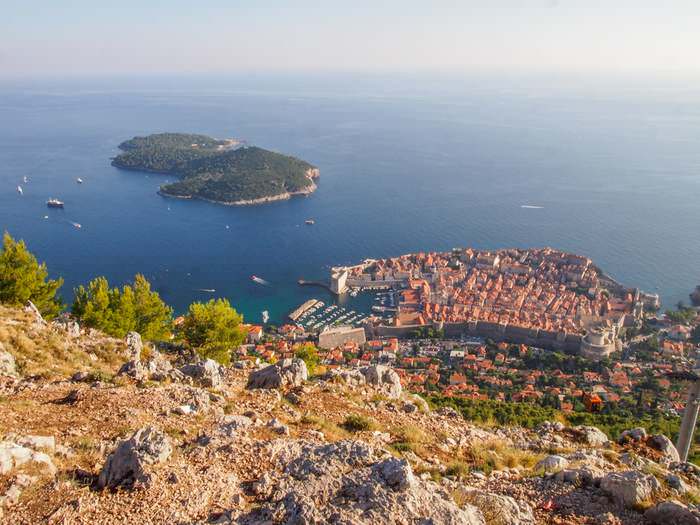
View of Lokrum Island and the Old Town from Mount Srđ
Next up—it will be late afternoon by now—is the iconic Dubrovnik Cable Car. This fast cable car leaves just north of the City Walls and brings people up to the top of Mount Srđ in mere minutes. The view of the city from up there is nothing less than phenomenal. You are strongly recommended to try and be there to catch the sunset.
Now, it’s time to head back down and enjoy that drink in a bar or restaurant on Stradun.
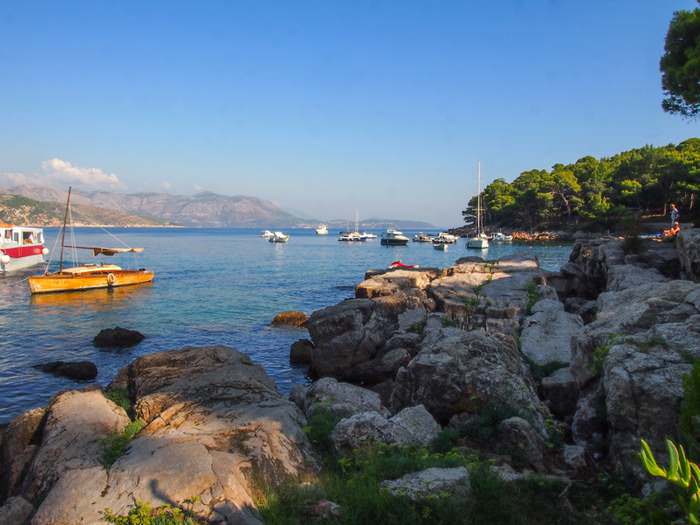
Peaceful Lokrum Island
Because all of the above attractions can be done in one activity-filled day, you can spend the following day exploring a little bit of Dubrovnik’s surroundings. A trip to nearby Lokrum Island is always popular among tourists and locals alike. Additionally, you may also want to soak up some sun at one of Dubrovnik’s beautiful pebble beaches. If I have to recommend one beach, it has to be Banje Beach, which without question has the best views.
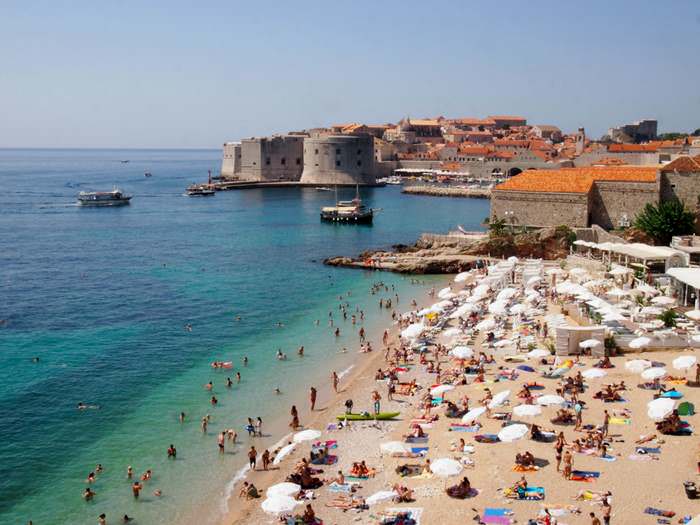
Banje Beach, the most scenic beach in Croatia
If you have more time to spend in Dubrovnik, you are encouraged to go on a day trip to one of the nearby towns. Particularly Kotor in Montenegro and Mostar in Bosnia and Herzegovina are amazing places to visit.
And if you are looking for a good deal on Hotels in Dubrovnik, take a look at our guide on where to stay in Dubrovnik.
Visit Dubrovnik – Pearl of the Adriatic was written by and photos by Bram Reusen for EuropeUpClose.com.
